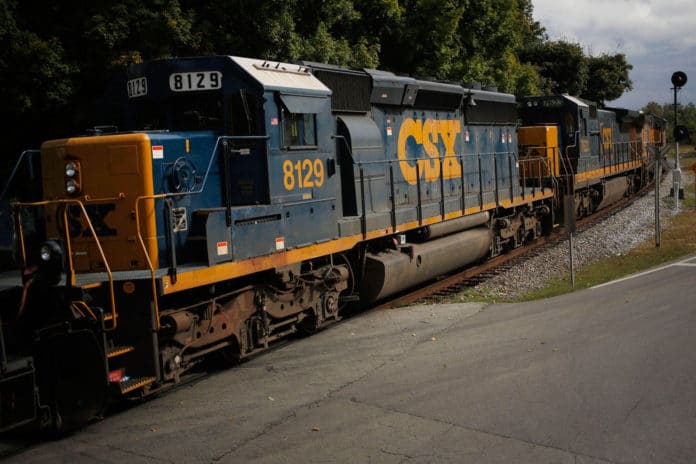Railroads lost cargo to trucks in the third quarter, adding to a yearlong slide in profits as demand tumbled for coal, oil and metals.
Intermodal cargo, goods hauled in containers, fell a second consecutive quarter for the first time since 2009, according to the Association of American Railroads trade group. A surplus of trucks has pushed down freight rates and lower diesel prices have chipped away at rail’s usual fuel-savings advantage, taking a toll on once-steady growth.
CSX Corp., the first major North American railroad to post earnings, is expected to report Wednesday that adjusted earnings fell 17 percent as the decline in intermodal traffic compounded a commodities slump. Container volume for the industry dropped 5.3 percent while all traffic declined 6.3 percent, according to the association.
“The rails have actually lost some cargo to trucks this year because the spot market is so pulverized and because diesel prices are relatively low,” said John Larkin, an analyst at Stifel Nicolaus & Co.
Railroads have invested in switching yards and the ability to double-stack containers to compete better with trucks for long-haul intermodal traffic, one of the few types of cargo with potential to grow faster than the economy. The segment makes up 40 percent or more of volume for railroads.
Meanwhile, truck freight has increased 3.5 percent this year through August, according to the railroads association.
Coal continues to be the biggest drag on U.S. rails, dropping about 16 percent in the third quarter. Demand is under pressure from rules to cut carbon emissions and as power plants burn cheaper natural gas. The decline has decelerated, however, from 28 percent in the second quarter and 33 percent in the first. CSX reported significant flooding, washouts and power disruptions from Hurricane Matthew this month, which may weigh on fourth-quarter results.
One of the few bright spots for the railroads is agriculture as a bumper crop helped drive third-quarter grain carloads up about 17 percent.
Railroads have reduced expenses by parking locomotives, furloughing workers and cutting investment. Train speeds have increased, helping improve operations.
“For the rails, it’s all about what they can do to mitigate the lower volumes,” said Lee Klaskow, an analyst at Bloomberg Intelligence. “With less traffic, they are able to run their networks more efficiently, so you could see margins improve despite the decline in volumes.”
CSX is expected to report adjusted earnings of $423 million, or 45 cents a share, according to the average of analyst estimates compiled by Bloomberg. Revenue is predicted to fall 8.5 percent to $2.69 billion.
Analysts estimate that profit will drop 11 percent for Union Pacific Corp. and 10 percent for Norfolk Southern Corp. Union Pacific, the largest publicly traded railroad, is scheduled to report on Oct. 20, and Norfolk Southern on Oct. 26.
Investors have driven up rail stocks this year, betting that the worst of the volume decline has passed. Railroads are expected to begin recovering in the fourth quarter as they lap last year’s weakness.
CSX’s shares gained 17 percent this year through Tuesday, outpacing a 4.5 percent gain for the Standard & Poor’s 500 Index. Union Pacific jumped 23 percent and Norfolk Southern climbed 12 percent.






